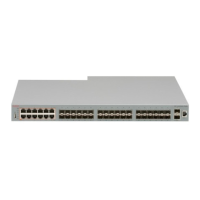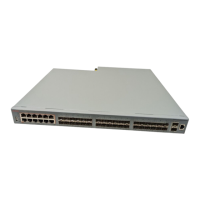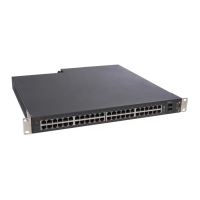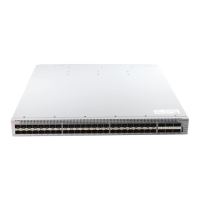Do you have a question about the Avaya 4550T-PWR+ and is the answer not in the manual?
Information about changes for this release that apply to features.
Modified ACLI commands for ARP, Spanning Tree, and VLAN to use Cisco CLI syntax.
Control Layer 2 FDB entries to prevent MAC tables from filling unnecessarily.
Load balance traffic on equal cost paths to the same destination prefix.
System sends IGMP general queries to designated sources in Layer 2 mode.
Supports IGMPv3 Snooping and Proxy for multicast traffic optimization.
Enhanced PoE settings and IP Phone discovery for priority levels and power limits.
Supports configuration of brouter ports for routing IP packets and bridging non-routable traffic.
Monitor multiple traffic patterns simultaneously using multiple port mirroring instances.
Enhancements to LAGs for consistent operation and VLAN changes on trunks without disabling.
Supports Simple Network Time Protocol (SNTP) and Network Time Protocol (NTP) for time synchronization.
Specify the IPv4 source address of outgoing ICMP requests for testing.
Secure transfer of Agent and diagnostic files and configuration files using SFTP.
Introduces four ERS 4800 Series models supporting Small Form factor Pluggable Plus (SFP+) devices.
Display FLASH capacity and current usage information.
Secure shell protocol for connecting to SSH Server devices.
Increased security for SSH login using RSA public-private key encryption.
More robust switch discovery and reports on stack communication failure.
Configure a static MAC address entry in the Layer 2 Forwarding Database (FDB).
System saves terminal settings across login sessions.
Supports up to 1,024 concurrent VLANs for faster configuration.
Enhanced Voice VLAN for centralized creation and management.
Sections for changes that do not apply to new features.
Introduces six new hardware models to the Avaya Ethernet Routing Switch 4000 Series.
An 802.1X-capable RADIUS authentication server for network access control.
DAUR feature is disabled in Release 5.6.
Enhancements to the Enterprise Device Manager (EDM) user interface.
Describes types of licenses and features requiring a license, supporting trial and advanced types.
Process for generating a license file on the licensing portal after purchasing a license kit.
Contains procedures for license file generation and prerequisites.
Explains Avaya Command Line Interface (ACLI) for switch configuration and management.
Describes the use and purpose of ACLI command modes.
Procedures for accessing ACLI.
Describes help available in ACLI at all levels.
Information to start and use Enterprise Device Manager (EDM) for managing switches.
Lists Internet Web browsers supported by EDM.
Specifies memory requirements for Configuration and Orchestration Manager.
Online help is context-sensitive and appears in a separate window.
Describes the parts of the Enterprise Device Manager window.
EDM initial view displays basic switch information.
Real-time physical view of the front panel of a device or stack.
Describes the parts of the EDM window.
Applying configuration changes to single ports using EDM.
Applying the same configuration changes to more than one port using EDM.
Procedures for starting and using Enterprise Device Manager (EDM) on your switch.
How to enable and configure Enterprise Device Manager (EDM) using ACLI.
Procedure to enable and manage the Web server using ACLI.
Procedure to disable the Web server using ACLI.
Procedure to display the Web server status using ACLI.
Procedure to configure and maintain your switch through a Web-based graphical user interface.
Using shortcut menus in EDM Device Physical View to edit objects.
Navigating around Enterprise Device Manager (EDM) and opening folders and tabs.
Viewing more than one tab at a time by undocking them.
Re-docking an undocked tab using specific methods.
EDM dialog boxes contain editable fields for parameter values.
Procedure to edit a dialog box.
Procedure to insert an entry in a dialog box.
Procedure to delete an entry from a dialog box.
Editing objects in the Device Physical View.
Procedure to edit an object using the shortcut menu.
Procedure and job aid to edit file system elements.
Using ACLI to display, store, and retrieve configuration files.
Procedures to display, store, restore, and save configuration files using ACLI.
Procedure to view the current running configuration using ACLI.
Lists standards supported on the switch.
Lists RFCs for information about networking concepts, protocols, and topologies.
Two options to connect to the switch: remote and console.
How to start a configuration using ACLI from the main menu.
ACLI provides four command modes for performing functions.
Commands to restart the switch using the factory default configuration.
Commands to configure and verify the Management IP Address.
Commands to configure SNMP.
Commands to configure NTP and verify the configuration.
Commands to configure VLANs and tagged uplinks.
Commands to configure IGMP.
Commands to configure a port.
Commands to configure ACLI passwords.
Commands to configure SSH.
Command to disable Telnet access.
Commands to configure SNTP.
Commands to configure log settings.
Commands to configure SSL.
Commands to configure access control.
Command to display the switch configuration.
Determines the ACLI mode required for a command.
| Model | 4550T-PWR+ |
|---|---|
| Device Type | Switch |
| Power Over Ethernet (PoE) | Yes |
| PoE Standard | IEEE 802.3af, IEEE 802.3at |
| PoE Budget | 740W |
| Switching Capacity | 176 Gbps |
| Forwarding Rate | 131 Mpps |
| RAM | 512 MB |
| Power Device | Internal power supply |
| Voltage Required | 100-240 VAC |
| Operating Temperature | 0 °C to 45 °C |
| AC Input Voltage | 100-240 VAC |
| AC Input Frequency | 50/60 Hz |
| Enclosure Type | Rack-mountable |
| MAC Address Table Size | 32K entries |
| Routing Protocol | OSPF |
| Remote Management Protocol | SNMP |
| Features | Flow control, VLAN support, Quality of Service (QoS), IGMP snooping, DHCP support, IPv6 support |
| Compliant Standards | IEEE 802.1D, IEEE 802.1p, IEEE 802.1Q, IEEE 802.3, IEEE 802.3u, IEEE 802.3ab |
| Storage Temperature | -40°C to 70°C |
| Humidity | 10% to 90% (non-condensing) |
| Management | Web-based management, CLI, SNMP |
| Ports | 48 x 10/100/1000Base-T |











